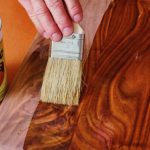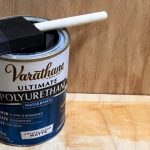Can You Stain Wet Wood? Know The Risks Involved
It is best to stain wood while it’s dry and has a moisture content below 15%. However, there may be situations where you have wet wood that needs staining and no time to let it dry. In such cases, you may wonder if it is possible to stain the wood while it is still wet.
So, can you stain wet wood? Yes, you can stain wet wood through proper preparation and using ideal stain types. Quick dry the wood and apply the wood conditioner before you add the wood stain. However, staining wet wood has downsides and risks, including longer drying time and microorganism growth.
Read on for the detailed steps to follow and successfully apply stain on your wet wood. You’ll also learn the potential risks and downsides of staining wet wood.
How Wet is Manageable When Staining Wet Wood?
As mentioned above, you can stain wood while wet by following the steps discussed further below. However, the stain may not adhere to the wood and will discolor. The final product is usually less durable and unaesthetic compared to dry wood.
Wood is a hygroscopic material that readily absorbs water from the atmosphere. When wood is wet, its pores are occupied by water, and the stain cannot penetrate deep. Wood stains must penetrate deep into the wood to create a strong and durable finish on the wood.
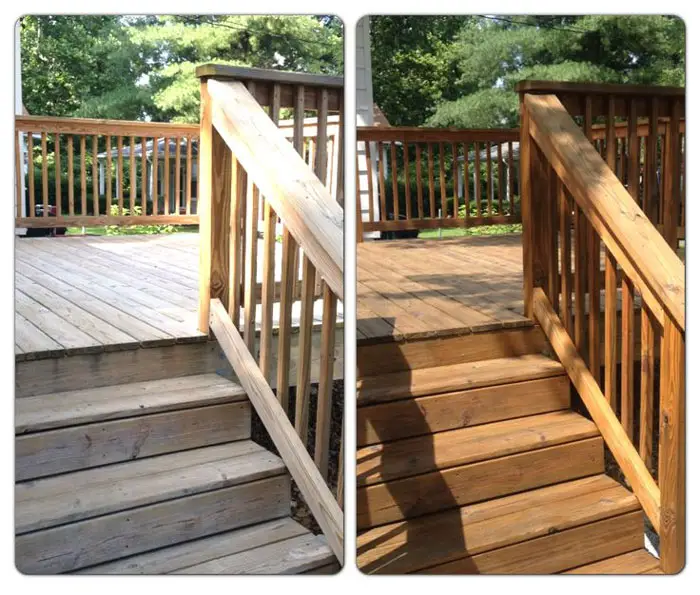
The level of wetness is the most influential factor determining whether staining is possible. Damp wood is often manageable and, in most cases, can be stained without causing issues. However, wood that is soaking wet should not be stained at all.
Green wood has a high level of moisture, usually 100%, and to be stainable must be dried or seasoned. If this wood is under 30 days since it was pressure-treated, it shouldn’t be stained.
How To Stain Wet Wood Successfully
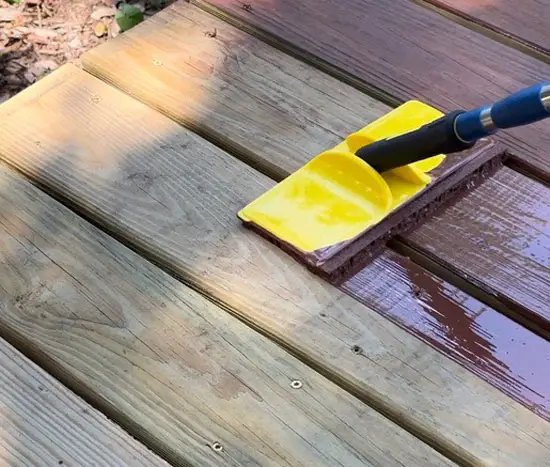
When you have no option but to stain wet wood, follow the steps below to apply stain on the wood.
1. Preparation
Assess the moisture content on the wood and attempt to fast dry it if it’s too wet. You can use the fast-drying options, like heating with a hair dryer or placing the wood under direct sunlight.
Clean the wood surface from dirt, debris, or previous finish. You can use fine-grit sandpaper for this. Don’t use water or liquid cleaners during the preparation.
Also, consider using a water-based wood stain instead of an oil-based one. Oil-based wood stains will not mix with the water in the wood since oil and water are immiscible. However, water-based wood stains will easily mix with the water.

2. Use Pre-Stain Wood Conditioner
Add a wood conditioner to the wood to improve stain absorption and adhesion. Consider using a conditioner specifically made for dealing with wet wood. Also, it should be compatible with the stain you are using.
Apply the pre-stain wood conditioner using a cloth or brush and allow it time to dry before applying the stain. The conditioner should take between 30 and 2 hours to dry.
3. Apply the Stain
Apply the first wood stain sparingly using a brush, cloth, or other ideal applicator. The stain should be applied to improve drying time, as thicker coats take longer to dry.
Also, it’s best to work in a small section at a time for better consistency. If staining a wooden deck, start with vertical surfaces and then the horizontal ones.

4. Wipe the Excess
Use a clean cloth to wipe the excess wood stain from the wood. Failure to do this can increase the already longer-than-usual drying time. Also, it will ensure even distribution.
5. Allow Enough Drying Time
Place the wood in a room with enough airflow and low humidity and let it dry. Usually, oil-based stains dry quicker, within 12 hours, while water-based options take up to 24 hours.
Downsides and Risks of Staining Wet Wood
The following list contains several downsides and risks associated with staining wood while it’s still wet.
Low Durability
The first downside of staining wet wood is the low durability of the final piece. The stain won’t adhere properly to the wood, creating a loose connection that risks damage in no time.
As mentioned earlier, the stain must get into the wood through its pores to create a strong finish. The water already occupying the pores will prevent this strong bond from forming. The result is a stain finish prone to flaking, wearing, or peeling off sooner than expected.
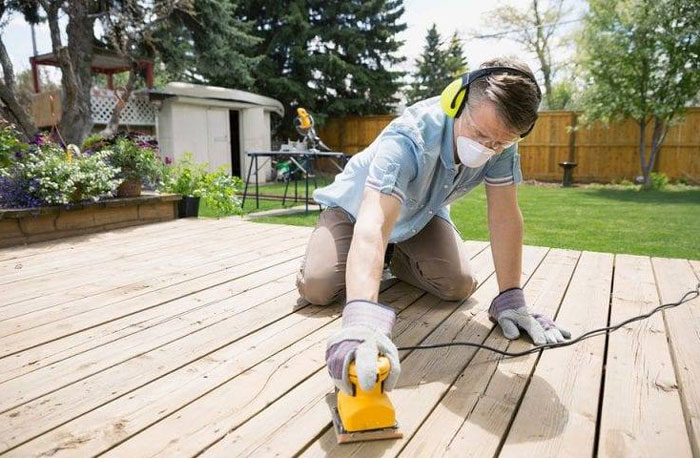
Uneven and Blotchy Appearance
Another downside of staining wet wood is the unpleasant and uneven appearance the wood gets. The water in the pores will prevent absorption of the stain, resulting in a blotchy appearance.
The stain will not spread or absorb the wood stain evenly, resulting in undesirable aesthetic outcomes. The moisture in the wood will also cause the grains to swell, causing an uneven or rough textured finish on the wood.
Discoloration
Moisture in the wood also affects the color of the finish stain, resulting in the unintended color. The water on the wood can dilute the stain color, especially when working with water-based wood stain, causing a lighter color than expected.
The wood will also appear darker in some areas since the wood stain is not absorbed evenly on the wood.
Increased Drying Time
The presence of moisture in the wet wood will also affect the wood stain’s drying time. The wood stain will take longer to dry due to the water from the wood wetting the wood stain while it dries.
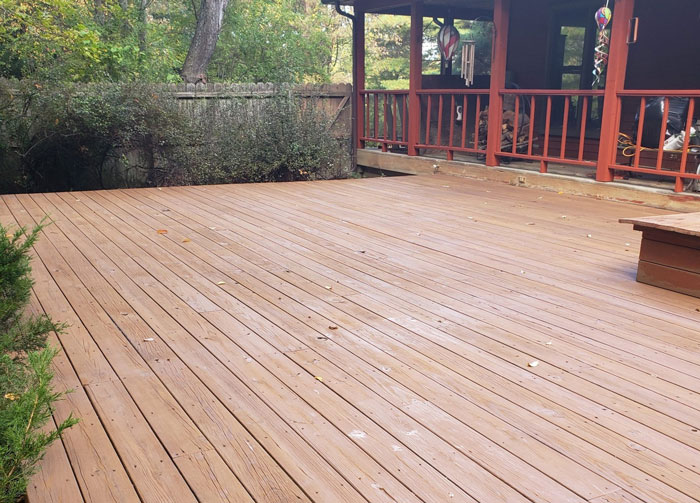
Risk of Microorganisms
Microorganism growth is one of the risks of staining wet wood. Mold, mildew, and wood destroying fungi thrive in moist areas, which wet wood provides. Given that staining traps the humidity inside the wood, these microorganisms will start breeding and growing.
When these microorganisms grow, the wood will get discolored and develop musty odors.
Structural issues
Another potential risk associated with staining wood while still wet is structural damage to the wood. Moisture weakens the wood, making it more prone to warping, cracking, and bending.
Besides, the microorganisms discussed earlier can also damage the wood, making it more vulnerable to damage.
Related Questions
Following are answers to questions frequently asked about the possibility of staining wet wood.
Q1. How Dry Should Wood Be Before You Can Stain It?
Ideally, the wood should look and feel dry before you apply a wood stain finish. You can use sandpaper to determine if the wood is dry enough. The sandpaper should not become wet or sticky. For better results, use a wood moisture meter.
Q2. Can You Stain Fresh Cut Wood?
Freshly cut wood should not be stained as it has a high moisture content, usually between 50% and 200%. The wood must be allowed enough time to dry, with the time-varying with the wood species and thickness.
Q3. How Long Should You Allow Wet Wood To Dry Before Applying Stain?
Recently rained-on or cleaned wood that was already dry can be stained after 48 – 72 hours, depending on the humidity. Also, the wood should not come into contact with water within 48 hours after the stain is added.
Final Thoughts
Precisely, it’s possible to stain wet wood, but the final product will be less aesthetic and durable than dry wood. Fast drying processes, like using a space heater, blow drier, or heat lamp, are ideal for reducing moisture content in the wood before staining.
The wood stain type you use will affect the staining process’s success. Use water-based stain and conditioner options on the wet wood, as they’ll adhere better. However, allow the wood enough time to dry for a better-looking and durable finish.



